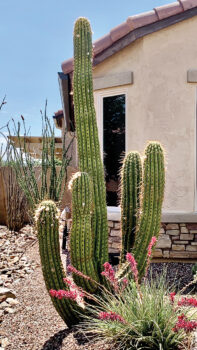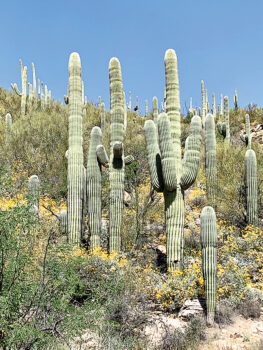
 Sheilah Britton
Sheilah Britton
For many of us who live in SaddleBrooke/SaddleBrooke Ranch, the saguaro (pronounced “suh-wahr-oh”) Carnegiea gigantea is a much sought after and central focal point of your landscape palette. It has, after all, been an iconic symbol of the Southwest since the mid-1800s and grows only in the Sonoran Desert in Arizona, Mexico, and California. We are fortunate to have Saguaro National Park on both the east and west sides of Tucson, where we can walk amongst these giant sentinels; some of the most beautiful saguaros in the world. The park covers nearly 150 miles of mountains and desert scrub.
The saguaros we have in our yards are relatively young for the most part, as they grow very slowly. A young cactus might grow only one to two inches in its first eight years. They usually don’t flower until 35 years and extend their first arm near 50 years of age. Around 125 years, a saguaro is considered an adult. “The Grand One,” the largest saguaro on record, lived to be 200, was 46 feet tall, and had more than a dozen arms. A wildfire damaged the cactus in 2005 and it died a few years later.
A deep taproot anchors the saguaro, and additional roots grow close to the surface of the ground to absorb water. Supported by a ribbed skeleton, its pleated flesh expands to retain moisture. In late May and early June, saguaros burst into crowns of white blossoms. The blooms mature into red fruit that have long been a source of nutrition for native peoples. The saguaros offer a refuge for birds, bats, insects, and mammals. Even in death, millipedes, snakes, and lizards find shelter and shade in fallen saguaros.
Around 50 years ago, a doppelgänger cactus, Cardón Grande Echinopsis terscheckii was introduced into the United States (presumably California) from the Monte Desert in Argentina. It has been nicknamed the Argentine “Saguaro,” but is more accurately designated an Argentine Cardón. Many of these cacti live in our neighborhoods and are often mistaken for saguaros.
Unlike the Sonoran Desert saguaro, the Cardón can grow in different types of soil, will thrive both in full and in partial shade, and is hardy at a minimum temperature of 15°F. It is a much faster growing cactus than the saguaro and can grow up to a foot a year with extra water and good soil. Branches extend low on the Cardón and appear much sooner than they do on the saguaro. Golden spires are fewer but longer, and in western exposures seem to glow in the late afternoon and early evening. Its tubular, white flowers bloom between April and October, eventually producing a bluish-green, round fruit.
Whether you have chosen a Sonoran Desert saguaro or an Argentine Cardón, or simply enjoy the cacti of others, these desert centaurs continue to reign as symbols of strength and survival in the Southwest.
Questions, comments, and suggestions are welcome by emailing ranchwords@gmail.com.
SaddleBrooke/SaddleBrooke Ranch Master Gardeners are volunteers trained under the auspices of the University of Arizona, Cooperative Extension, Pinal County. We offer educational programs and classes to residents of our communities.
We invite you to visit our website if you are interested in becoming a Master Gardener or for current events and information regarding landscape and gardening in the high desert at www.saddlebrookemastergardeners.org.
In addition to exploring desert gardening basics, plant identification, and informational links, we have a helpline that provides volunteer assistance year-round. Contact Don Lawson at rustysan@icloud.com.
